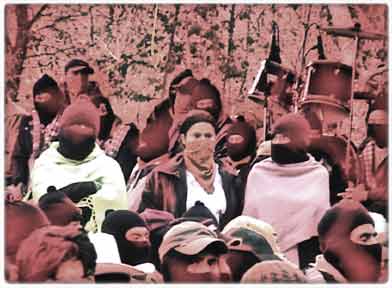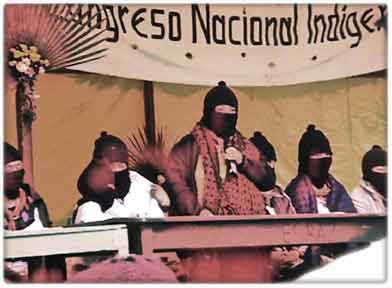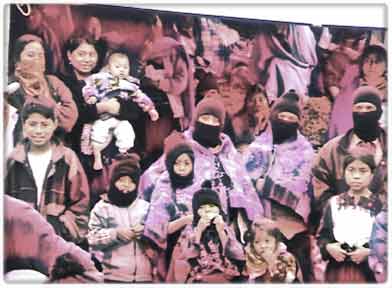- Significant ties to illegal paramilitaries found in Colombia’s Congress and President Álvaro Uribe’s Administration
- Colombia negotiating with and showing leniency to mass-murdering “narcoterrorists”
- U.S. acting suspiciously uncritical of Colombia’s refusal to extradite known drug traffickers
- Elimination of extradition undermines the Colombian phase of the “war on drugs”
- White House increases annual aid levels to Colombia from about $728 million to $750 million
Soon President Bush will be visiting Colombia, the largest recipient of U.S. aid in the hemisphere, where he is expected to discuss the current state of U.S. - Colombian counter-narcotics initiatives. However, this trip inauspiciously comes at a time when Bogotá is witnessing an unprecedented series of political scandals. After the surrender late last year of Salvatore Mancuso, ex-leader of the notorious right-wing paramilitary group, the Autodefensas Unidas de Colombia (AUC), international focus has ironically shifted from his crimes to those of his captors. After turning himself in and ceremoniously giving up his pistol, Mancuso admitted to participating in acts of kidnapping, drug trafficking, murder, and torture during his time in command of the AUC. His confession, which gained him near-unlimited immunity, has expanded, though, to accuse many top Colombian politicians of supporting and aiding the AUC in the militia’s merciless crusade that has devastated rural communities and killed thousands of campesinos. To corroborate these accusations, Mancuso provided the court with a copy of the “Ralito Agreement”, a veritable treaty of cooperation signed by leaders of the AUC, as well as eleven members of the Colombian Congress, two provincial governors, and five mayors. Despite the substantial evidence of widespread corruption, Washington, and certainly a visiting President Bush, will have little motivation to querulously chide the U.S.’s favorite Latin American spear carrier.
From Rape to Riches
Formed in 1997, the AUC began as a small militia available as hired vigilantes to local ranchers being threatened by kidnapping, physical assault, or even murder by leftist guerillas. Although it continued to claim that its intention was to check the power of groups like FARC and ELN, the AUC’s mission grew increasingly violent as it began working solely as a right-wing death squad to further the interests of the wealthy political elites. Continuing under the guise of its “patriotic” pursuit, the AUC committed grievous crimes against thousands of innocent victims and escalated internal strife in Colombia.
The AUC’s tactics, which included kidnapping, mass-murder, torture, rape, forced disappearances, and assassination, were so horrific that, out of embarrassment, the U.S. had to eventually add the group to its list of terrorist organizations, which ironically also included ELN and FARC guerillas, groups that the vigilante body had been created to fight. But in addition to brutal and inhumane tactics against suspected leftists, the AUC’s grisly campaign targeted non-combatants like trade unionists, human rights advocates, liberal politicians, and even Colombian peasants that the paramilitaries labeled as left-wing sympathizers. However, even after the AUC was designated by the U.S. State Department as an “international terrorist organization,” the paramilitary group continued to grow and eventually its violence wantonly grew to include a ghastly campaign to ‘socially cleanse’ Colombia of homosexuals and other groups that it designated ‘undesirable’.
To fund its efforts the AUC found a comfortable niche in the Colombian drug-trafficking industry and with its considerable military power and wide-spread ideological support, it was able to achieve notable successes within this violent and dangerous trade. As a result of the rise in the group’s financial resources, the paramilitaries gradually began focused on participating in Colombian politics. By the end of the 1990s, the AUC began coercing votes for a cadre of selected national and local candidates who were already sympathetic or potentially supportive of its cause. During this period, the AUC also expanded its use of narcotics’ profits to bribe or eliminate less ideologically-friendly politicians, police, and armed forces’ personnel. The success of these efforts, according to Mancuso, was that the AUC rapidly came to control numerous local governments and a stunning third of the national legislature by 2001.
Estranged Bedfellows?
Mancuso’s surprising willingness to turn himself in was not due to a guilty conscience or lack of places to hide. Instead, it was the result of tailor-made Colombian legislation shaped by President Uribe’s administration that, with the alleged intention of luring the group to demobilize, set an atrociously low maximum eight year sentencing limit for AUC leaders in return for their surrender. This means that Mancuso, who admitted to personally committing over 300 murders, orchestrating dozens of bloody massacres, and trafficking massive amounts of narcotics, will ultimately serve less prison time than a tax evader. Even though Bogotá has pointed to many expected benefits of its clemency program, it should be noted that the AUC commanders who surrender are not required to actually ensure that their troops fully disarm . As a result, the country has failed assuage its critics’ doubts that this leniency towards the AUC may be a hugely one-sided quid pro quo.
Up until the late 1990s, Colombia’s military employed many of the same bloody and internationally condemned tactics against left-wing groups fighting in the country’s civil war, as those utilized by AUC Field Commanders currently on trial. However, because of growing international outrage over the military’s reviled methods, the U.S. was forced to politely criticize the Colombian authorities, and under Clinton, even cut back aid to specific units of the Colombian Army. Due to congressional pressure and U.S. threats to continue decreasing financial assistance, Bogotá began exercising a measure of greater control over its military’s deplorable practices. Conveniently for the Colombian government, though, after it was forced to rein in its army, right-wing paramilitary militias like the AUC were ready and willing to pick up the baton and ensure that the pace of mass-murders and kidnappings never slackened.
The AUC’s brutality against left-wing guerrillas allowed it to quickly gain popularity among Colombian politicians and military officers who saw it as the way to continue an all out war with leftist guerillas while providing a plausible opportunity for denying official involvement. This freedom to operate without constraint, along with the better pay offered by the AUC, lured large numbers of Colombian military personnel into the group’s ranks, many of whom retained important links within the armed forces. Not surprisingly, this led to a situation where Colombian military officials, including the former head of the country’s intelligence agency, Jorge Noguera, were providing intelligence and hit-lists to AUC field commanders and, in some truly horrendous cases, participating directly in planned massacres, or simply remained seated as the mass-murders were being carried out.
America the Dutiful
In 1996, President Ernesto Samper was accused by Washington of accepting a six million dollar contribution from the Cali Cartel for his presidential campaign. The U.S. immediately condemned the president, canceled his U.S. visa, and decertified Colombia in its annual evaluation of Bogotá’s performance in the “War on Drugs.” This led to a significant decrease in the funds supplied to Colombia that injured the country’s economy and eventually forced Samper to step down.
However, even at the risk of again incurring the U.S.’s wrath, Colombian officials suspended Mancuso’s arrest warrant in 2004 so that he could address the Colombian Congress. To an astonishing volume of enthusiastic applause, Mancuso declared to a full house that “the judgment of History will recognize the goodness and nobility of [AUC’s] cause.” Although the warm reception for Mancuso outraged those who had grievously suffered as a result of the AUC’s hideous crimes and cast serious doubts on Bogotá’s appetite for fighting right-wing paramilitaries, the U.S. remained aloof on the issue and made little effort, at least publicly, to castigate the Colombian government. This outrageous indifference, when compared to Washington’s earlier harsh and assertive responses to Colombia’s past “softness” on both drug and human rights policies, represented a tell-tale lapse in the U.S.’s moral code. Unfortunately, this stumble in U.S. policy became emblematic of a greater trend that, in effect, mortally wounded Washington’s anti-drug strategy in Colombia.
When Mancuso was taken into custody last year by Colombian officials, Washington was quick, but perhaps only superficially, to request his extradition. However, Colombia uncharacteristically refused to honor the U.S.’s wish, citing that the terms of its demobilization agreement with AUC strictly forbid the authorities to extradite any AUC leaders who had surrendered and were cooperating with the authorities. Nonetheless, this surprising refusal was met by an even more startling passivity by the U.S., which ultimately revoked its request. This act essentially compromised Washington’s all-important extradition strategy. Strangely it was allowed to take place even though the U.S. ostensibly still had a very strong bargaining position, as it had already dispersed over $4.3 billion in military and anti-drug supplies and could have probably pressured Colombia into extraditing Mancuso. This coming fiscal year, the Bush Administration proposes to award Colombia with another $750 million in aid, making the country the largest recipient of U.S. aid in the hemisphere and the third largest worldwide. But with a precedent now set for Colombia to deny extraditions, the U.S. has lost an essential, if not a pivotal tool in the “War on Drugs” that may not easily be substituted with merely increased funds. Whether the State Department was simply becoming more accepting of Colombian recalcitrance or is scaling back its coercive diplomacy, its uncritical and even magnanimous position towards Colombia’s decision to give away the store when it comes to negotiating with “narcoterrorists,” was stupefying.
However, to make matters worse, the U.S. went beyond mere silence. In 2007, long after substantial proof of grievous government corruption had surfaced, the U.S. Chairman of the Joint Chiefs of Staff, General Peter Pace, visited Colombia and referred to Bogotá as a valuable ally in the “War on Terror.” As what could only be the product of a laconic or bemused speechwriter, General Pace even went on to exclaim that Colombia’s efforts to fight internal militias, like the AUC, were “truly remarkable.” Apparently, this must have been a reference to leftist rather than rightwing internal militias as AUC leaders, designated by the State Department as “international terrorists” were already being given a generous clemency rather than justice.
Few to Blame in a Uni-Polar World
Currently, even though it has received such ill-deserved flattery, the Colombian government has recognized the severity of its plight. On February 15, 2007 the country’s Supreme Court ordered the arrest of six congressmen, including Alvaro Araújo, brother of the foreign minister, because of their alleged links with AUC. As a result of the arrest of her brother, Foreign Minister Maria Consuelo Araújo voluntarily stepped down from her post on February 19, further adding to suspicions that connections with the AUC may have permeated the upper tiers of government.
With the hope of regaining legitimacy, both the conservative and liberal sides of the Colombian legislature have called for new congressional elections. Although this bid at the redemption of democratic bona fides may appear to justify Washington’s inappropriate praise for Bogotá, this is not the case. The controversy should more accurately be framed as a major embarrassment for Washington, because it either did not spend the necessary time to closely investigate the issue or purposefully chose to ignore the facts that ineluctably would have lead it to the conclusion that it was involved in a hazy anti-drug quagmire. Instead, the White House is preparing to squander hundreds of millions of U.S. taxpayer dollars in aid to Colombia.
In spite of all this, President Bush still plans on extending the honor of a personal visit to Colombia during his limited tour of the region from March 8 through14. The meeting with Uribe has been slated to discuss the U.S.’s commitment to fighting “narcoterrorism,” which will surely broach the prospects of continued U.S. aid under the aegis of Plan Colombia II, despite the disappointing results of the current Plan Colombia. Any ensuing talks will certainly be affected by concerns of internal corruption and a lingering awkwardness over the fear that Colombia has been a lost servitor to Washington. The two leaders in fact, have very much to talk about; both are weakened presidents whose leverage has deeply suffered because of their misdeeds.
Another Missed Wakeup Call?
With such dramatic levels of drug-fueled corruption being met with almost affable indifference by U.S. officials, it is not difficult to assume that there may be a double standard at work. Colombia is the United States’ closest ally in South America and the importance of its willingness to comply with U.S. initiatives is crucial because of the recent political successes by leftist candidates in the region. It may be plausible that the U.S. has been turning a blind eye to Colombia’s corruption with the hope that right-wing paramilitaries could stem the leftist tide within the Andean nation.
The recent arrests of six congressmen and the call for new elections intimates that Bogotá may be now taking corruption there more seriously than the U.S. If Washington continues to treat Latin America as a secondary concern and insists upon using antiquated Manichean tactics to isolate such foes as Venezuela while codling Uribe, it could quickly find its few remaining regional allies straying off
This analysis was prepared by COHA Research Associate Kevin Alexander Watt with research contributions by COHA Research Associate Marc Sutton










